| The Two-Part Conductus: Morphology, Dating and Authorship6 |
| 音楽エッセイのページへ戻る | 初期多声音楽 | St.マーシャル楽派へ |
| Leoninのページへ | ノートルダム楽派(conductus)のページへ |
ペロタン(Viderunt Omnes) |
| ペロタン(Alleluja Nativitas) | ペロタン Clausulaのページ | まうかめ堂さんのページへ |
| substitute clausulaのページへ | 中世音楽のページへ | その7へ進む |
| その5へ戻る |
| The Two-Part
Conductus: Morphology, Dating and Authorship6 by Jacopo Mazzeo その6(p109〜130) 2.1.2. Peculiarities of Framing Caudae and Internal Caudae In some cases caudae can, as previously mentioned, transcend a merely musical function, and gloss or comment on the meaning of the song, or even enrich the song with brand new meaning. Sursum corda elevate is partly based on the Sanctus and the Agnus Dei of the Mass, and survives as a two-voice conductus in multiple sources.18 It also survives as a three-part conductus in one fragmentary source only, F-ME 732bis/20 (1r). The length of the caudae, which increases progressively throughout the song, might be seen as leading to a climax that reflects the advice stated in the first line of the poem: sursum corda elevate (lift up your hearts). The song begins with a much flourished first line. Then, despite the hesitation on dominum in the third line of the first stanza, it presents progressively lengthy internal caudae, and ends eventually with the longest melisma on the final word pacem. <Sursum corda elevate> いくつかのケースでは、caudaeは前述のように、単に音楽的な機能を超えて、歌の意味を注釈を付けたりコメントしたり、まったく新しい意味で歌を豊かにすることができる。 Sursum corda elevateは、ミサのSanctusとAgnus Deiに部分的に基づいており、多くのの資料で2声conductusとして存続している。それは、1つの断片的資料F-ME 732bis/20(1r)に3声のconductusとして現存している。caudaeの長さは、歌を通して次第に増大し、詩sursum corda elevateの最初の行に記載されているアドバイスを反映した盛り上がりにつながると考えられるだろう。この曲は、栄えある一行から始まる。それで、最初のスタンザの第3行のdominum上に躊躇しているにもかかわらず、それはますます長いinternal caudaeを示し、最終的には最後の語pacem上の最長のメリスマで終わる。 Fraude ceca desolato is a further conductus preserved in most sources as a twovoice song, and in one source only as a monody.19 In the polyphonic version the length of the caudae increases proportionally towards the end, from 20 to 118 perfections. In the last stanza the internal caudae on ingenitus and celitus accentuate the rhyme. Moreover, the cauda on ingenitus covers a second function; it closes the first part of the stanza, mirroring the cauda on semita in the previous stanza. The melisma on ingenitus has then two purposes, while celitus just one. This is mirrored in their length: the first one, of 18 perfections, is more than twice longer than the second one, of just seven perfections. Fraude ceca desolato shows to what degree internal caudae are significant to emphasise relationships among parts of the text. <Fraude ceca desolato> Fraude ceca desolatoは、ほとんどの資料で2声部の歌として保存されている。.1つの資料でのみ単声として扱われている。多声バージョンでは、caudaeの長さは、最終部位に向かって比例し、20から 118 perfectionsへと増え続ける。最後のスタンザでは、ingenitus と celitus上のinternal caudaeが韻を強調する。さらに、ingenitus上のcaudaは、第2の機能をカバーしている。それは、前のスタンザのsemita上のcaudaを反映して、スタンザの第1部を終止させる。 ingenitus上のメリスマは2つの目的を持っているが、一方、celitusはただ1つである。これは、その長さに反映されている。18perfectionsのうち、最初のものは2番目のものよりも2倍長く、7perfectionsである。 Fraude ceca desolatoは、テキストの部分間の関係を強調するために、internal caudae がどの程度重要であるかを示している。 Although internal caudae can be used to musically enrich the meaning of the text, framing caudae occasionally also offer such a musical gloss. Though these caudae typically assume a structural framing function, there are several examples in which they highlight striking numerical relationships. For instance Transgressus legem Domini,which is found as a two-voice and three-voice conductus,20 shows a proportional relationship among framing caudae. Initial and terminal caudae in the second stanza are twice as long as the ones in the first stanza, as shown in Table 2.3. internal caudaeは、テキストの意味を音楽的に豊かにするために使用することができるが、framing caudaeは、時にはそのような音楽の注釈を提供している。これらの caudaeは、典型的には構造的なフレーミング機能を前提としているが、数値的な関係を強調するいくつかの例がある。例えば、Transgressus legem Dominiは、2声ないし3声のconductusであることが判明しており、framing caudaeとの間で比例関係を示している。Table 2.3に示すように、第2スタンザのInitial and terminal caudaeは、第1スタンザの長さの2倍である。  Another two-voice conductus, Ortu Regis Evanescit,21 is representative of one of the most remarkable means to enrich musica cum littera, the chain of assonances and consonances. Two caudae on or- (ortu) and ro- (rosa) gloss the vowel o at the opening of the two main sections of the first stanza (see Table 2.4). The long cauda on -lu- (soluta) represents the closure of the stanza, while -um (convallium) underlines its assonance with the vowel u. The pattern of caudae on repetitions of vowels is especially clear in the second stanza. There the vowel e is marked through a flourishings set to hec, que and te- (tenet; at the beginnings of the first, second and third line respectively), while melismas on the “os” of the words sanctiore, vilegio, vitio, and rore (at the ends of the fourth, fifth, sixth, and seventh line respectively) all highlight the vowel o. In the last stanza, the vowel i is first highlighted on the syllables -vi- (divitias, second line) then on -ti- (delitias, fourth line); followed by a switch to the vowel a in -la-(gratulatur, fifth line) and a- (alias, last line). <Ortu Regis Evanescit> 別の2声conductus、Ortu Regis Evanescit、は、類韻と協和の連鎖であるmusica cum litteraを豊かにする最も顕著な手段の1つを示している。 or-(ortu)とro-(rosa)上の2つのcaudaeは、第1スタンザの2つの主要セクションの冒頭で母音oに注釈を付す(Table 2.4.参照)。 -lu-(soluta)の長いcaudaはスタンザの終了を示し、-um(convallium)は母音uとのr類韻を強調する。母音の繰り返しによるcaudaeのパターンは、第2スタンザでは特に明瞭である。そこでは、母音eはhec、que、te(tenet;それぞれ最初、2番目、3番目の行頭にある)に設定されている。sanctiore、vilegio、vitioなどの "os"とrore(それぞれ4番目、5番目、6番目、7番目の行末)が母音oを強調表示する。最後のスタンザでは、母音iが最初に音節-vi-(divitias、2番目の行)で強調表示され、次に-ti-(delitias、4番目の行)で強調表示される。母音a-la-(gratulatur、5行目)とa-(alias、最後の行)に切り替える。
The four-stanza conductus Legem dedit olim deus22 (Table 2.5) represents a further example of the exploitation of caudae with the purpose of highlighting chains of assonances. 22 <Legem dedit olim deus> 4つのスタンザを持つconductusLegem dedit olim deusは、類韻を強調する鎖の目的としてのcaudaeの発展のさらなる例である。 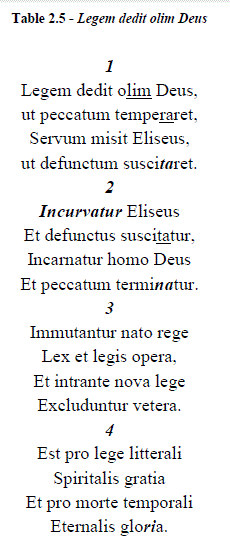 The musical profile of the first pair of stanzas appears rather different from the last two stanzas of the song. Stanzas one and two, with rhyme scheme abab-acac, have three caudae each and in general deliver quite flourished music. On the contrary stanza three has no caudae at all and the last stanza only a terminal melisma. The rhyme scheme is also different as the two stanzas do not share any rhyming syllable (dedefgfg). The musical design of the first two stanzas clearly shows the composer’s intention to highlight similarities, flourishing the penultimate syllables of second and fourth lines in both stanzas, -ra (temperaret), -ta (suscitaret), -ta (suscitatur) and -na (terminatur), which assonate with each other (Figure 2.4 and Figure 2.5). The caudae on temperaret and suscitatur also mark the ends of clauses in their own respective stanzas. 最初の2組のスタンザの音楽プロファイルは、その曲の最後の2つのスタンザとはかなり異なるように見える。 韻のスキームabab-acacを持つ第1、第2スタンザはそれぞれ3つのcaudaeを持ち、一般的にはflourishな音楽を提供します。 対照的に、第3スタンザにはcaudaeが全くなく、最後の第4スタンザは最終のメリスマのみを持っている。 2つのスタンザが韻律シラブル(dedefgfg)を共有していないので、韻のスキームも異なっている。 最初の2つのスタンザの音楽デザインは、同様性や、両スタンザにおける第2,4行-ra(temperaret)、-ta(suscitaret)、-ta(suscitatur)、-na (terminatur)の最後から2番目のシラブルをflourishすることを強調する作曲家の意図をあきらかに示している。それらはお互いに類韻をしている(Figure 2.4 and Figure 2.5)。temperaretと suscitaturのcaudaeはまた、それら自身のそれぞれのスタンザのclausesの終止を記している。 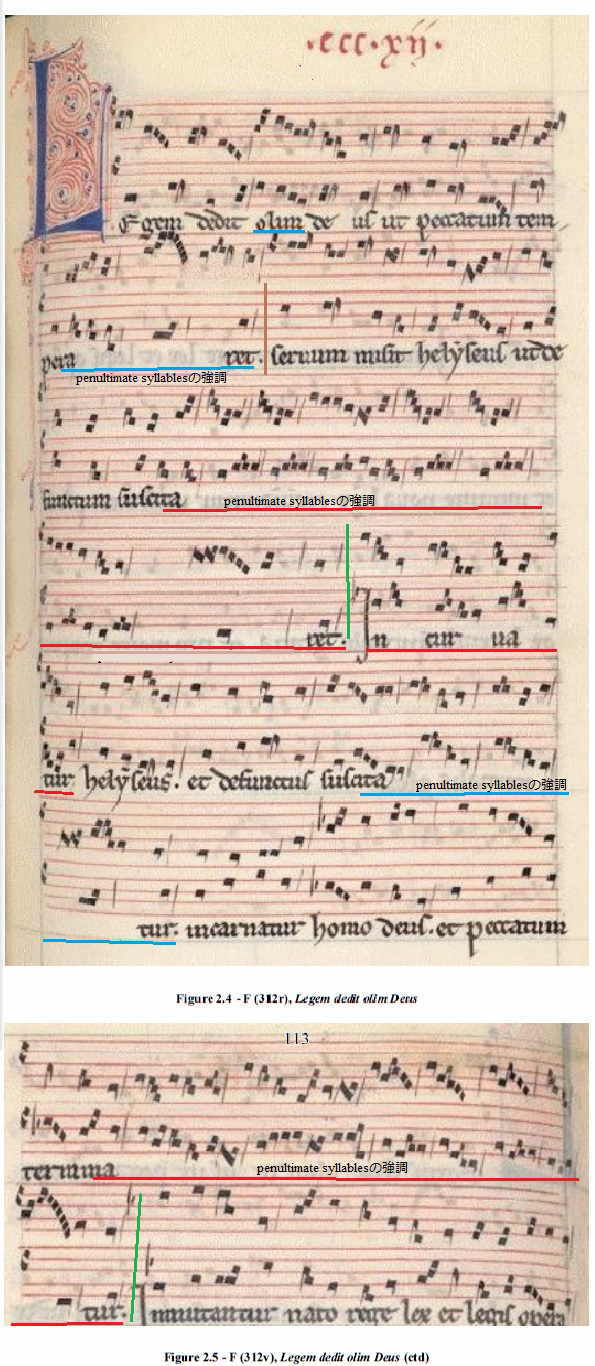 The musical design is not the only feature that differentiates the two sections of the song. Although the rhyme scheme is fairly consistent within all stanzas (alternate rhyme), the author of the poem exploits quite a peculiar rhyme technique in the first two. Moving from stanza one to stanza two he changes the rhyming syllables of lines 2 and 4 (from -ret to -tur), however applies a chiastic structure to lines 1 and 3 simply inverting the words Deus and Eliseus. Such a compositional device is however not exploited in the final two stanzas. On the one hand this may simply reflect a deliberate authorial choice. On the other hand it could suggest that the latter two sections of the song (the first two stanzas making sense on their own), may have been written and set to music at a later stage. 音楽のデザインは、歌の2つのセクションを区別する唯一の機能ではない。韻律技法はすべてのスタンザ(交代する韻)内に存在するが、詩の作者は最初の2つのスタンザにおける特殊な韻律技法を発展させる。詩の作者は最初の2つの韻律技法をかなり活用している。第1スタンザから第2スタンザに移動すると、2行目と4行目(-retから-turまで)の韻律音節が変更されるが、DeusとEliseusという言葉を単純に逆にして1行目と3行目にchiastic構造が適用される。しかしながら、このような作曲的工夫は、後の2つのスタンザでは利用されない。一方では、これは単に熟考された著作者の選択を反映しているに過ぎない。一方、それは、歌の後半の2つのセクション(最初の2つのスタンザはそれ自身で意味をなす)が、後の段階で書かれ、音楽に設定された可能性があることを示唆する。 A sizable number of internal melismas have the function to highlight a sequence of consonances in Ego reus confiteor.23 The phoneme “d” is highlighted with flourishes on de-, ad-, quod, and sed (words Deo, addictus, quod, sed), while the “s-sound” is underlined with melismas on san-, se-, sed, and sup- (words sanctisque, sepe, sed, supplicio). Luget Rachel iterum24 records only one internal cauda on la- (lapso), which throws into relief the “l-sound” already found on both initial caudae on luget and lan-(languent). In the conductus Scrutator alme cordium, where caudae are consistently set to all final syllables of lines, the composer adds further internal melismas on cum (Table 2.6), in order to rhyme the syllable -um found on lines 1, 3, 6, and 7. かなりの数の内部的なメリスマが、Ego reus confiteorの中で一連の協和を強調する機能を持っている。音素「d」は、de、ad、quod、sedの各単語で強調されている(Deo、addictus、quod、sed )、「s-音」はsan、se、sed、sup(単語sanctisque、sepe、sed、supplicio)のメリスマで強調されている。 Luget Rachel iterumは、la(lapso)上に1つのinternal caudaを記録している。これは、すでにlugetとlan(languent)の初期の両方のcaudaeで見つかった "l-音"を救済するものである。conductusScrutator alme cordiumでは、caudaeが常に最後のすべてのシラブルに設定されている。作曲家は、第1,3,6,7行にあるシラブル-umに押韻するために、cum(Table 2.6)上にさらなる内部メリスマを加えている。
Such a technique is taken to extremes in the last stanza of Salvatoris hodie,25 where the whole word mundus is set to a melisma before it is entirely repeated within the word immundus later in the stanza as a terminal cauda. Similarly a micro-cauda is set to the whole word hec in the first stanza of Hec est dies triumphalis,26 recalling the longer initial cauda of the stanza (Table 2.7). In the following two stanzas two different chains of consonances and assonances intersect with each other. The first one sets off with the very short initial cauda on du- (duce), and continues with -tur (infunditur), clau- (claustro), cum, and -sur- (consurgere); the second starts with both hec in the first stanza, involves again the melismas on clau- (claustro) and cum, and eventually moves to cor- (corde) in the last stanza. このような技法は、Salvatoris hodieの最後のスタンザでよくわかる。全体の言葉mundusは,terminal caudaとして後にスタンザにおいてimmundusという言葉とともに繰り返される前に、メリスマに設定される。同様に、micro-caudaは、Hec est dies triumphalisの第1スタンザの全体の言葉hecに設定され、スタンザのより長いinitial caudaを想起する(Table 2.7).。 次の2つのスタンザでは、2つの異なる協和と類韻の鎖が互いに交差する。 最初の方は、du-(duce)上の非常に短いinitial caudaとともに始まり、-tur (infunditur), clau- (claustro), cum, -sur- (consurgere)が続く。 第2部は第1スタンザのhecから始まり、clau(claustro)とcumのmelismasをもう一度巻き込み、最終的に最後の節のcor-(corde)に移動する。  Puer nobis est natus, whose text is given in Table 2.8, reveals a similar design.27 The composer stresses many occurrences of voiceless-dental-stop sound on -it (procedit), et, -vit, -tatis (veritatis), -it (consuluit), -tu- (periture). Micro-caudae are crucial to link the first stanza to the second: the micro-cauda on qui alliterates with the initial cauda on quos, while the two micro-caudae (and the longer internal cauda) on et. second stanza . recall the medium-sized internal cauda on et in the first stanza, partially exploiting the same melodic material (Music Example 2.5 and Music Example 2.6).Music Puer nobis est natusは、Table 2.8に示されているが、同様のデザインを示している27。作曲家は、-it (procedit), et, -vit, -tatis (veritatis), -it (consuluit), -tu- (periture)上の無声歯破裂音の多くの発生を強調する。 Micro-caudaeは最初のスタンザを2番目のスタンザに結びつけるために決定づける。qui上のmicro-caudaはquo上のinitial caudaとともに頭韻するが、その間、第2スタンザのet上の2つのmicro-caudae(および長いinternal cauda)は、第1スタンザのet上の中間サイズのinternal caudaを呼び起こす。同じ旋律素材を部分的に利用しながら。(Music Example 2.5とMusic Example 2.6).Music 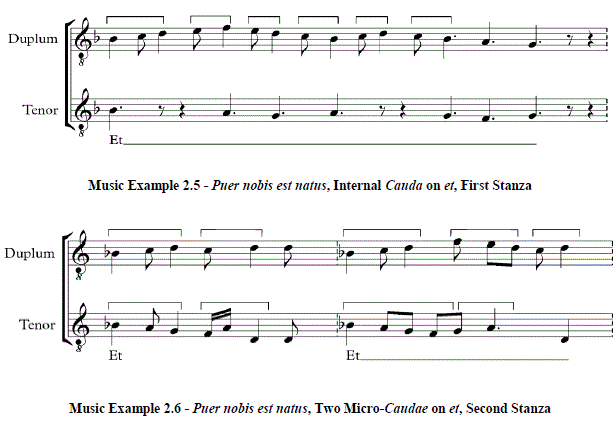 The characteristic use of micro-caudae in Puer nobis est natus is not an isolated case. The similar exploitation of micro-caudae in a sizeable amount of conducti seems to suggest that this type of melisma played a major role in the process of melodically linking similar sounds. Puer nobis est natusにおけるmicro-caudaeの特徴的な使用は、孤立したケースではない。 かなりの量のconductiにおける同様のmicro-caudaeの利用は、このタイプのメリスマが同様の音をメロディ的につなぐ過程において重要な役割を果たしていることを示唆しているようである。  The two-voice conductus Gaude Virgo Virginum is dedicated to the Virgin Mary, and recorded in all four main sources.28 It shows a remarkable focus on the syllable tu (Table 2.9). The repeated use of the vocative tu in the third stanza brings the poem to the peak of its devotional fervour; the composer decides to design music accordingly. An introductory 14-perfection-long tu is set to the first syllable of the stanza, the following repetitions (respectively first word of the third, fifth and sixth lines) are highlighted by micro-caudae of four to five perfections each. The composer spots the same syllable once again in the second line of the following stanza: he highlights the word tuti and the consonance te at the beginning of the line. 2人の声のコンダクターGaude Virgo Virginumは聖母マリアに捧げられ、4つの主な情報源すべてに記録されている.28それは音節tu(表2.9)に著しい焦点を当てている。 3番目の連の中でのボーカル・ツーの繰り返し使用は、その敬虔な情熱のピークに詩をもたらします。 作曲家はそれに応じて音楽をデザインすることを決定する。 初めの14完全長のtuがスタンザの最初の音節に設定され、次の繰り返し(それぞれ3番目、5番目、6番目の行の最初の単語)は、それぞれ4?5個の完璧な微小尾で強調表示されます。 作曲者は次の節の2行目に同じ音節をもう一度見つけます:彼は単語の先頭にtutiとconsonanceをハイライトします。  One last example of exploitation of micro-caudae for word-correspondence is found in the first stanza of the conductus Seminavit Grecia.29 The author of the poem repeats the word quod four times, three of which are highlighted by melismas of various lengths: the first is a micro-cauda, while the second and third are proportionally longer internal caudae. No musical material is shared between the three occurrences. Seminavit Grecia Seminavit Greciaの最初の節では、単語対応のための微虫の搾取の最後の例があります.29詩の作者はquodという言葉を4回繰り返し、そのうち3つは様々な長さのmelismasによって強調されています。 第1と第3は比例してより長い内部尾部であり、第2と第3は比例的により長い内部尾部である。 3つの出現の間で音楽的な素材は共有されません。 2.2. Differences between Cauda and Musica sine littera In the previous discussion of Ista dies celebrari cases of uncertain distinction between syllabic cum littera and melismatic music were found to be not uncommon, and this was seen to be replicated throughout the two-voice conductus repertory. Some cases, where the use of embellishments is particularly widespread over the whole song, raise a question: are cauda and sine littera simply two overlapping concepts? Indeed, the association of these two notions is due to our rigid understanding of the genre. In practice the terms sine littera and cauda tend to set the focus on two different ways of viewing melismatic music. 前のIsta dies celebrari の議論では、シラビックなcum litteraとメリスマ的音楽との間の不確実な区別の例は珍しくないことが判明し、これは2声conductusのレパートリー全体に複製されていることが分かった。装飾の使用が特に歌全体に広がっている場合、caudaと sine litteraは単なる2つの重なり合った概念なのであろうか? 確かに、これらの2つの概念の関連付けは、ジャンルの厳密な理解によるものであるが、実際には、litteraとcaudaという用語は、メリスマ的な音楽を見るための2つの異なる方法に焦点を当てる傾向がある。 Philosophically speaking, the first highlights the relation between music and text, the expression “sine littera” means in fact that the music flows without the presence of words. On the contrary, cauda can be considered merely a musical term; it may refer to a melisma, regardless of its relation to the poem. As a consequence, musica sine littera will always embody a cauda, yet a cauda would not always be entirely “without words”. An obvious instance of such caudae “with words” is the long list of melismas over the words Benedicamus Domino, which will be discussed in paragraph 2.3. 哲学的には、最初は音楽とテキストの関係を強調しているが、“sine littera”という表現は実際に言葉の存在なしに音楽が流れることを意味する。逆に、cauda は単なる音楽用語と考えることができる。それは詩との関係にかかわらず、メリスマを指すかもしれない。結果として、musica sine littera は常にcauda の具現化となるが、caudaは必ずしも完全に「言葉なし」であるとは限らない。 「言葉を伴う」そのようなcaudaeの明白な例は、Benedicamus Dominoという言葉に対するメリスマの長いリストである(第2.3節で論じる予定)。 In Deus creator omnium, a two-voice conductus in F, W1, and Ma,30 the poet describes God in the act of creating life and the Garden of Eden. The composer seems to take the poem’s words fecit quecumque voluit (he made whatsoever he wished) literally, and designs the whole song “as he wishes”, in such a way that boundaries between cum and sine littera are blurred. Most of the cum littera music appears considerably elaborate right from the very beginning of the song, but starting from the fourth line of the first stanza melismas run all over the following lines. From that point onwards, besides a few syllables carrying single notes in both tenor and duplum, the music runs mostly melismatically until the end of the stanza (Figure 2.6). At this stage, theconductus reverts to a conventional layout, with clear distinctions between syllabic musica cum littera and melismatic musica sine littera. Yet, it goes back to that peculiar melismatic design after the fourth line. Deus creator omniumでは、F、W1、Ma中の2声のconductusや詩人は人生を創造する行為とエデンの園で神を描いている。作曲家は、詩の言葉fecit quecumque voluit(彼は彼が望むものを作った)を文字通りとみなし、cum litteraと sine litteraの境界がぼやけているように、歌の全体を "彼が望むように"設計する。cum littera音楽のほとんどは、曲の最初からかなり精巧に見えるが、第1スタンザの第4行から始めると、メリスマはこの行にずっと続いていく。この時点(第4行)以降さらにまた、数少ないシラブルがテノールとdupllumの両方に単一の音符を持ち、音楽はほとんどメリスマ的に、スタンザの終わりまで続く。(Figure 2.6).。この段階では、conductusは従来のレイアウトに戻り、シラビックなmusica cum littera とメリスマ的な musica sine litteraとの明確な区別をしている。それでも、それは第4行の後のその独特なメリスマ的なデザインに戻る。 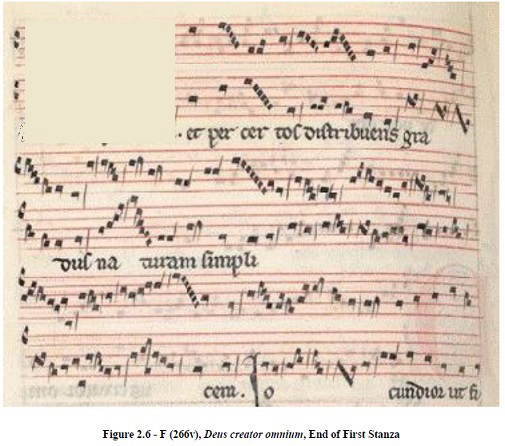 Puer nobis est natus follows the previous song in the manuscript F, and curiously presents similar features. Melismatic music, despite some syllabic interruptions, runs over the words procedit et (first stanza), reformavit qui celos inclinavit et (second stanza, Figure 2.7), veritatis nascens mundo consuluit et plebe periture (second stanza), and -gatur in terris conversatur (third stanza), after which point the conductus shifts to remarkably plain syllabic music, until its end on the cauda set to nunciatur. Puer nobis est natusは、F写本の前の曲Deus creator omniumに続き、奇妙なことに、同様の特徴を提示する。メリスマ的な音楽は、いくつかのシラビックな中断にもかかわらず、procedit et (first stanza)、reformavit qui celos inclinavit et (second stanza, Figure 2.7), veritatis nascens mundo consuluit et plebe periture (second stanza), -gatur in terris conversatur (third stanza)で出現する。その後、conductusは、非常に平易にシラビックな音楽に移行し、それはnunciaturへのcaudaまで続く。  The case of Sine matre genitus appears even more striking in its surprising strong contrast between first and second part of the song. Caudae of any length are indeed found at any point of the conductus, yet cum littera sections are clearly separated from internal caudae, as far as the first stanza and first part of the second stanza areconcerned (Figure 2.8). Towards the middle of the second stanza flourished music findsits way over words, so that boundaries between melismatic and syllabic music disappearonce again (Figure 2.9). Sine matre genitusの場合は、曲の第1部と第2部との間の驚くほど強いコントラストにおいてさらに顕著に見える。どんな長さのCaudaeも確かにconductusのどの時点でも見つかるが、第1スタンザと第2スタンザの最初の部分に関する限り、cum litteraセクションはinternal caudaeから明確に分離されている(Figure 2.8).。 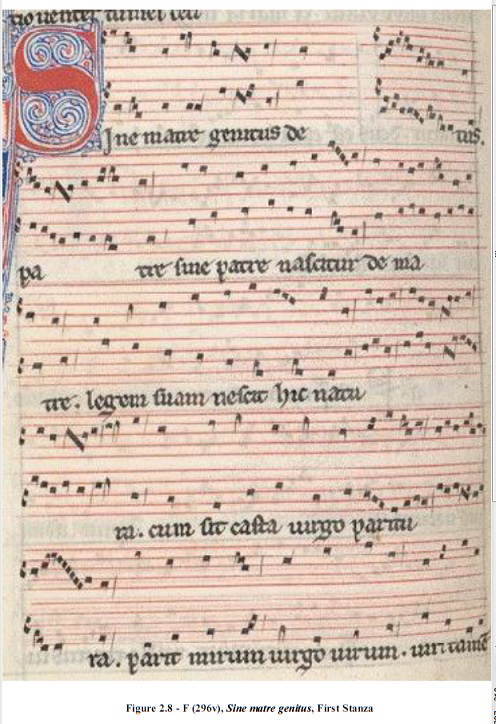 第2スタンザの真ん中に向かって、栄えある音楽は言葉を超えた道を見つけ出すので、メリスマ的音楽とシラビック音楽の境界は再び消える(Figure 2.9).。 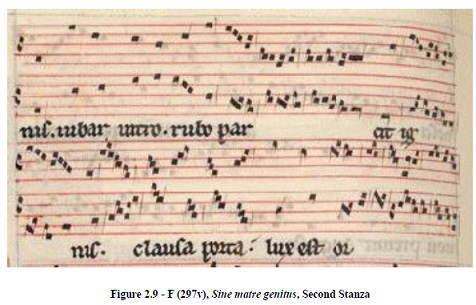 A further similar example is the cum littera section in the first stanza of Iamvetus littera,32 where the words appear literally overwhelmed by melismatic music. The composer spreads two long melismas over the whole second part of the stanza, above the words servabant gentium patent and et lex sequacibus quid confert tedium (Figure 2.10). さらに類似した例は、Iamvetus litteraの第1スタンザのcum litteraセクションであり、ここで言葉は文字通りメリスマ的な音楽に圧倒されて現れる。作曲家は、2つの長いメリスマをスタンザの第2部全体servabant gentium patent とet lex sequacibus quid confert tediumに広げる。(Figure2.10)。  The conducti Deus creator omnium, Puer nobis est natus and Iam vetus littera show sporadic instances of unclear separation between melismatic and syllabic music. Further examples include Condimentum nostre spei, Resurgente Domino, and Rex eterne glorie mundo.33 The passage “with words” at the beginning of the second stanza of Condimentum nostre spei (Figure 2.11) is clearly not meant to interrupt the flow of melismatic music, which runs nearly consistently from hec to clausos. conducutiDeus creator omnium, Puer nobis est natus Iam vetus litteraは、メリスマ的音楽とシラビックな音楽の不明瞭な分離の散発的な例を示している。 さらなる例は、Condimentum nostre spei、Resurgente Domino、Rex eterne glorie mundoを含んでいる。Condimentum nostre spei (Figure 2.11)の第2スタンザの初めにある "言葉を伴う"句hecは、明らかにメリスマ的な音楽の流れを妨げるものではなく、それはhecからclausosまでほぼ一貫している。 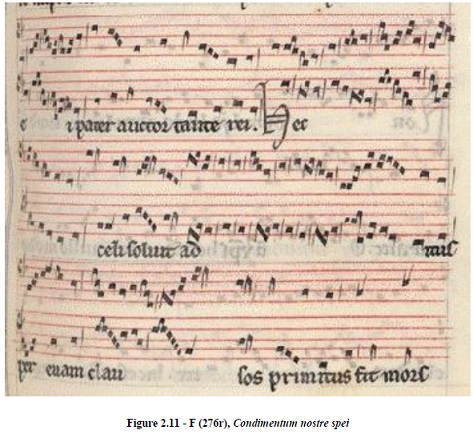 Even more strikingly, Resurgente Domino presents a lengthy and rich melismatic passage that spreads over the whole final stanza (Figure 2.12), from mors to vincitur, with only a short completely syllabic section over et vincendo vinci-. さらに注目すべきことは、Resurgente Dominoは、mors から vinciturまで、最後のスタンザ全体(Figure 2.12),に広がっている長くて豊かなメリスマ的なパッセージを提示している。  Rex eterne glorie mundo not surprisingly recalls the design just described for Resurgente Domino. Its second stanza is generically melismatic, with no clearly determined syllabic segments (Figure 2.13 and Figure 2.14). Rex eterne glorie mundoは、驚くことにResurgente Dominoについて述べたものを想起させない。その第2スタンザは、明確に決定されたシラブル分画(Figure 2.13 and Figure 2.14)を持たない、一般的にメリスマ的なものである。   There are four further pieces where no real syllabic cum littera can be identified: Lene spirat spiritus, Dum sigillum summi patris, Porta salutis ave and Celorum porta.34 The peculiarly short texts of Celorum porta and Porta salutis ave are rare . thus not representative of the whole repertoire, and to many degrees these pieces are unique indeed; however their musical design seems consistent with the features previously discussed.35 Both have essentially no syllabic music, and only a very few passages come close to the cum littera sections seen above. シラビックなcum littera特定されないLene spirat spiritus、Dum sigillum summi patris、Porta salutis ave、Celorum portaの4つの作品がある。 Celorum portaとPorta salutis aveの特有の短いテキストはまれであるため、全体のレパートリーを代表するものではなく、これらの作品は実際にはユニークなものである。しかし、彼らの音楽的デザインは以前に論じた特徴と一致しているように見える。両者は本質的にシラビックな音楽を持たず、非常に短いパッセージが、上記に見られたcum littera部門にあるだけである。 In Porta salutis ave only the words vhe quia tollis (last line) articulate syllabic music in both bottom and upper part, anticipating the final cauda. Similarly in Celorum porta, just the words tua nos clementia are set to syllabic music. The only extant record of this song, in F, shows rather clear erasures where the music for those words is given (Figure 2.15). Porta salutisでは、final caudaに先立って、上下の声部でシラビックな表現している。同様にCelorum portaでは、tua nos clementiaという言葉だけがシラビックに設定されている。この歌の現存する唯一の記録であるF写本では、その言葉の音楽が与えられているところではっきりとした消し跡を示している(Figure 2.15).。 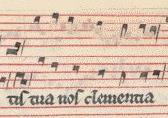 Figure 2.15 - F (332r), Celorum porta As this conductus is a unicum it is not possible to compare this version with other testimonies in order to verify whether the erasure constitutes a deliberate amendment of the upper voice. However the hypothesis that an original version of the song envisaged some more flourished cum littera for this passage as well should not be excluded. このconductusはunica(F写本のみに現存する)なので、このバージョンと他の写本のものとを比較して、消去が上声部の意図的な修正の結果なのかどうかを検証することはできない。しかし、このパッセージのために、実はもう少しflourishなcum litteraが構想されていたという仮説も除外すべきではない。 Neither Dum sigillum summi patris nor Lene spirat spiritus reaches the extreme levels of ornamentation found in the two previous conducti. However, once again most of the music of both pieces is flourished, and the syllabic cum littera plays a minor role. In Dum sigillum summi patris syllabic music is consistently set to any repetition of the noun sigillum (seal), and the verb fecundare (to fecundate). In the first stanza we find syllabic music on sigillum summi, sigillo summe, and nec sigillum … sigillum deitatisdetrimentum; in the second stanza on ex contactu fecundatur, and que dant vires fecundandi. On the contrary the composer tends to mark the verbs signare (to mark) andosculare (to kiss) with extensive melismatic music (melismatic sections underlined in Table 2.10). Dum sigillum summi patrisもLene spirat spiritusも、前の2つのconducti.で見受けられた極端なレベルの装飾には達していない。しかし、もう一度、両方の作品の音楽の大部分がflourishになると、シラビックなcum litteraはマイナーな役割に回ることになる。 Dum sigillum summi patrisでは、sigillum summi, sigillo summe, nec sigillum … sigillum deitatis detrimentum上のシラビックな音楽は、名詞sigillum(seal)と動詞fecundare(to fecundate)の繰り返しに一貫して設定されている。第1スタンザではでは、siglum summi、sigillo summe、nec sigillum ... sigillum deitatisdetrimentumに、第2スタンザではex contactu fecundatur, and que dant vires fecundandiに、シラビックな音楽がある。逆に、作曲家は、広範囲のメリスマ的音楽(表2.10に下線が引かれているメリスマ部分)を用いて、動詞signare(to mark))とosculare(to kiss)をmarkする傾向にある。 Table 2.10 - Dum sigillum summi patris 1 Dum sigillum summi patris Signatum divinitus, In sigillo summe matris Signatur humanitus, Nec sigillum castitatis In puella frangitur, Nec sigillum deitatis Detrimentum patitur. 2 Dum humanam osculatur Naturam divinitas, Ex contactu fecundatur Intacta virginitas; Mira virtus osculandi, Miranda sunt oscula, Que dant vires fecundandi Sine carnis copula. Lastly, Lene spirat spiritus presents no extensive syllabic sections whatsoever. Some proper cum littera is timidly sketched over the words spirat spiritus that follow the initial cauda, as well as in the subsequent stanza on rore pretermisso and nobis parit. 最後に、Lene spirat spiritusには、大規模なシラビックなセクションが存在しない。いくつかの適切なcum litteraは、initial cauda,の後に続く言葉spiral spiritusと、rore pretermissoとnobis paritの後続のスタンザで細々と描かれている。 |